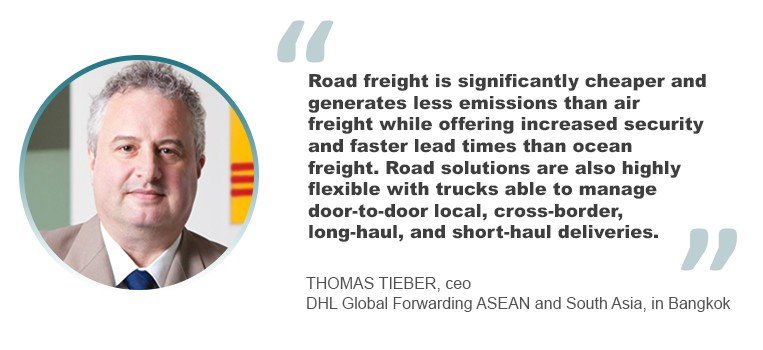Demand for road logistics in Southeast Asia is seeing increased demand with regulatory initiatives, ecommerce boom and the continued disruption in air and sea cargo prompting shippers to look at alternatives to move freight.
DHL said road freight – particularly in Southeast Asia – is becoming a more convenient option to transport cargo and prospects are bright for the segment with easing of trade restrictions and new regulatory initiatives in the region, such as the ASEAN Customs Transit System (ACTS) and the Regional Comprehensive Economic Partnership, bolstering intra-Asia trade.
Six ASEAN member countries connected by land borders – Cambodia, Laos, Malaysia, Singapore, Thailand and Vietnam – earlier started implementing the ACTS as part of the economic bloc’s move to harmonize trade in the region, citing a 40% cost reduction for overland transport within participating states.
“We are bullish on the long-term growth prospects of road freight in the region,” Thomas Tieber, CEO, DHL Global Forwarding ASEAN and South Asia, told Asia Cargo News from Bangkok. “The anticipated increase in Southeast Asia’s trade volume and economic activity is expected to translate into logistics and road transport demand.”
DHL Global Forwarding foresees a strong and sustained growth in cross-border road transportation in Southeast Asia where the ecommerce sector is expected to grow 5.5% in 2021.

Tieber said East Asian economies are expected to drive trade growth in 2021, with the ASEAN road freight market expected to witness a compound annual growth rate (CAGR) of more than 8% between 2020-2025.
The rise in ecommerce consumer spending and B2B ecommerce, which is predicted to see a 70% increase by 2027, is also pushing demand for door-to-door logistics solutions, he added.
Aside from economic reasons, DHL also noted road freight as being more environmentally-friendly as supply chain players seek to be more sustainable.
“Road freight is significantly cheaper and generates less emissions than air freight while offering increased security and faster lead times than ocean freight,” Tieber told Asia Cargo News. “Road solutions are also highly flexible with trucks able to manage door-to-door local, cross-border, long-haul, and short-haul deliveries.”
Tieber noted that customers are also increasingly choosing to truck their short- and long-haul shipments for all or part of the journey due to the reduced carbon emissions it offers as compared to air freight.
He said, for instance, an air-road shipment from Jakarta to Bangkok via Singapore cuts carbon emissions by half, in addition to cost savings of 35%, as compared to a direct flight. Meanwhile, trucking a shipment from Singapore to China reduces carbon footprint by 83% as compared to air freight.
Nonetheless, Tieber said, as with other modes of transportation, road freight is also affected by weather conditions and border congestions for various reasons.
He noted that while regulatory developments such as ASEAN Economic Corridor and ACTS will help pave the way for free movement of trucks across the border, “it will take some time for countries to enjoy the full benefits.”
With strong growth prospects for road freight, DHL Global Forwarding said it has invested in multi-modal solutions “for well over a decade in the region” – starting with a service between Singapore, Malaysia and Thailand, and today operating a network across ASEAN and China, with trucking services throughout landlocked countries and ferry services connecting archipelagoes such as Indonesia to its ASEAN road network.
“We see an increased demand to transport goods in several sectors using road and multimodal services in Southeast Asia,” Tieber added, noting that sectors seeing increased road transport include technology, engineering and manufacturing, fashion and apparel, automotive, life sciences and pharmaceuticals, ecommerce and retail.
Meanwhile, DHL Global Forwarding noted that while road freight transport has long been established in Europe and the United States, it only began “a decade ago” in Southeast Asia.
Since then, there’s been “tremendous improvement in the infrastructure” and growth in demand by customers, Tieber added.
“With the increase in trade volumes and economic activity in Southeast Asia, boosted by the ecommerce boom and the easing of trade restrictions, road freight in Southeast Asia is expected to continue to grow,” he said. “We also expect road freight in Asia Pacific to see strong growth.”
Citing a Transport Intelligence’s Regional Freight Forwarding COVID Recovery Tracker 2021, DHL noted that the Asia Pacific forwarding market will be 3.6% larger than it was at the end of 2021.
The report said China will continue to lead market growth in Asia Pacific as demand for Chinese goods from U.S. consumers continues to grow.
Charlee C. Delavin


